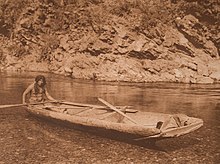
Back شعب يوروك Arabic Юрок BE Юрок Bulgarian Yuroks Catalan Jurokové Czech Yurok German Yurok Spanish Yuroks French יורוק HE Yurok Croatian
 Yurok man and canoe on the Trinity River by Edward S. Curtis, c. 1923 | |
| Total population | |
|---|---|
| 6,567 alone and in combination[1] (2010) | |
| Regions with significant populations | |
| Languages | |
| English, Yurok[2] | |
| Religion | |
| traditional tribal religion, Christianity | |
| Related ethnic groups | |
| Wiyot[2] |
The Yurok people are an Algic-speaking Indigenous people of California that has existed along the Hehlkeek 'We-Roy or "Health-kick-wer-roy"[needs IPA] (now known as the Klamath River) and on the Pacific coast, from Trinidad south of the river[which?]’s mouth almost to Crescent City along the north coast.[2][3]
The people of the Yurok Tribe traditionally identify as Oohl, a Yurok word simply meaning "the people."[4] Some historic documents, like the Yurok Tribe's unratified treaty with the Government of the United States (GoUS), refer to the Yurok Tribe as the Lower Klamath, Pulikla, or Poh-lik Indians[5][6] to distinguish the people of the Yurok Tribe from the "Upper Klamath" or "Peh-tsick" Indians, who are now known as the Karuk Tribe.[7] The name Yurok is derived from the Karuk word yúruk va’áraaras, meaning "downriver people; i.e. Yurok Indians".[8][9] American ethnologist George Gibbs first recorded the term as 'Yourrk' while traveling with Col. Redick McKee in 1851, and mistakenly used it as the name of the tribe in his book, Observations on the Indians of the Klamath River and Humboldt Bay, Accompanying Vocabularies of Their Languages, published in 1887. These names all developed from the way the river was, and still is, centered in the worldview of the people of the Yurok Tribe. Traditionally, the people of the Yurok Tribe would refer to villages down river as Pue-lik-lo' (meaning 'Down River Indian'), villages upriver as Pey-cheek-lo' (meaning 'Up River Indian'), and villages on the Pacific coast as Ner-'er-ner' (meaning "Coast Indian"). However, all these terms were merely practical descriptions of how to get to or from a village location within the Ancestral Land of the Yurok Tribe; the Pue-lik-lo', Pey-cheek-lo' and Ner-'er-ner' were, and are, all still Oohl.
The Yurok people live primarily within the exterior boundaries of Yurok Reservation and surrounding communities in Humboldt, Del Norte and Trinity counties. Although the reservation comprises some 56,000 acres (23,000 ha) of contiguous land along the Klamath River, only about 5,000 acres (2,000 ha) of scattered plots are under partial tribal ownership. Most Yurok land is owned by timber corporations or is part of national parks and forests.[10] This forest management has significantly disempowered the Yurok people and disrupted their ability to access natural resources, land, and practice Indigenous lifeways.[11]
- ^ "2010 Census CPH-T-6. American Indian and Alaska Native Tribes in the United States and Puerto Rico: 2010" (PDF). census.gov.
- ^ a b c White, P. (January 10, 2024). "California Indians and Their Reservations: An Online Dictionary". San Diego State University Library. Retrieved March 5, 2024.
- ^ Gray-Kanatiiosh, Barbara A. (2007). Yurok. ABDO Publishing. pp. 4–7. ISBN 9781617849145.
- ^ "Our History". Yurok Tribe.
- ^ Karuk Tribe of California v. Ammon, 209 F.3d 1366, 1371 (Fed. Cir. 2000)
- ^ "Yurok Tribe Constitution". Yurok Tribal Code.
- ^ Super v. Work, 3 F.2d at 90–91 (1926).
- ^ Andrew Garrett, Susan Gehr, Erik Hans Maier, Line Mikkelsen, Crystal Richardson, and Clare Sandy. (November 2, 2021) Karuk; To appear in The Languages and Linguistics of Indigenous North America: A Comprehensive Guide (De Gruyter Mouton), ed. by Carmen Jany, Marianne' Mithun, and Keren Rice [1]
- ^ "Yurok Tribe Scoping Comments on the Klamath Hydroelectric Project EIR" (PDF). www.waterboards.ca.gov. January 29, 2016.
- ^ Huntsinger, Lynn; McCaffrey, Sarah (1995). "A Forest for the Trees: Forest Management and the Yurok Environment, 1850 to 1994" (PDF). American Indian Culture and Research Journal. 19 (4): 155–192. doi:10.17953/aicr.19.4.cv0758kh373323h1.
...the Yurok have been dispossessed of most of their territory. The majority is now owned by timber corporations or is part of national parks and forests. Although the Yurok Reservation includes a contiguous area of fifty-six thousand acres along the Klamath River, in 1995 only scattered parcels, comprising less than five thousand acres of the reservation, are under some semblance of tribal ownership, with the rest mostly in non-Indian hands. Historically, despite the granting of a reservation and allotments to Yurok people, control of reservation and allotment natural resources has been withheld from them under the auspices of scientific forest management.
- ^ Huntsinger, Lynn; McCaffrey, Sarah (1995). "A Forest for the Trees: Forest Management and the Yurok Environment, 1850 to 1994" (PDF). American Indian Culture and Research Journal. 19 (4): 155–192. doi:10.17953/aicr.19.4.cv0758kh373323h1.